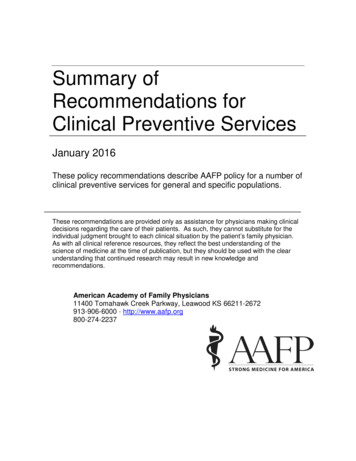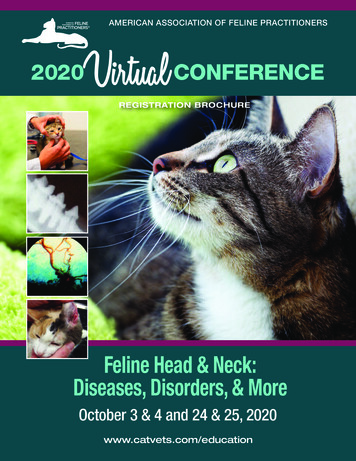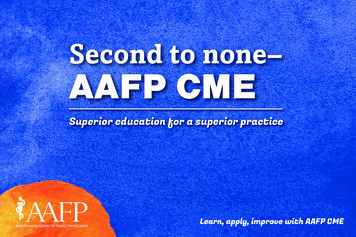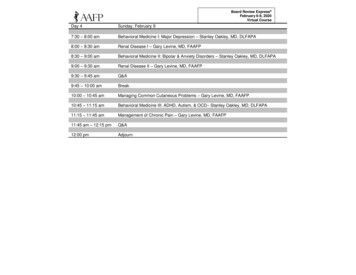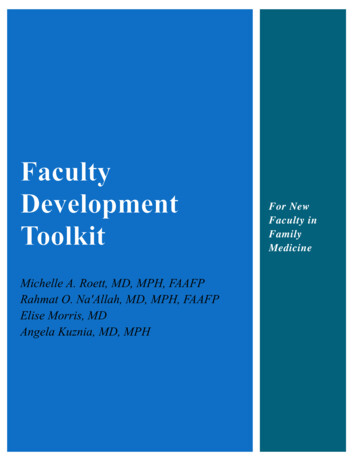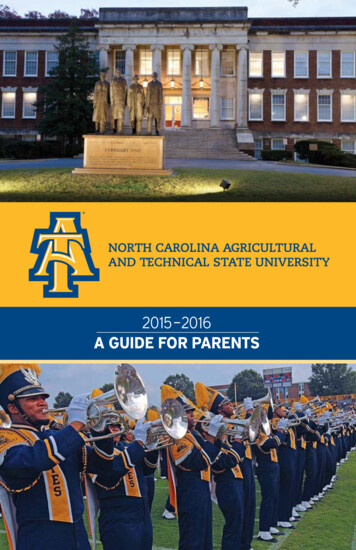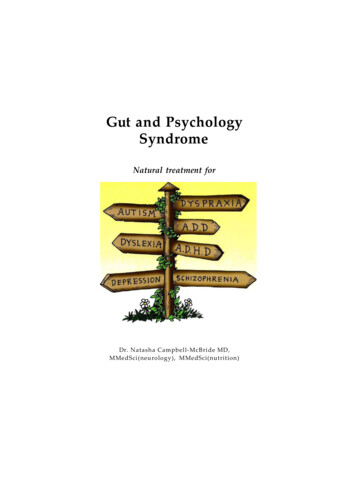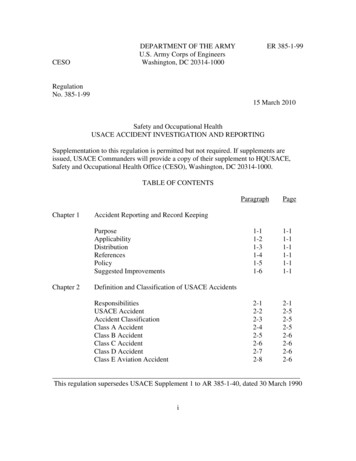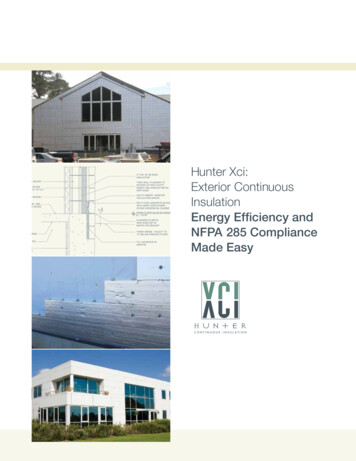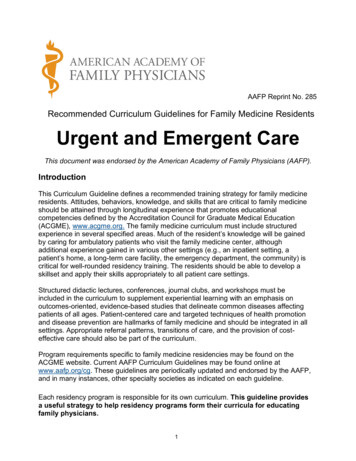
Transcription
AAFP Reprint No. 285Recommended Curriculum Guidelines for Family Medicine ResidentsUrgent and Emergent CareThis document was endorsed by the American Academy of Family Physicians (AAFP).IntroductionThis Curriculum Guideline defines a recommended training strategy for family medicineresidents. Attitudes, behaviors, knowledge, and skills that are critical to family medicineshould be attained through longitudinal experience that promotes educationalcompetencies defined by the Accreditation Council for Graduate Medical Education(ACGME), www.acgme.org. The family medicine curriculum must include structuredexperience in several specified areas. Much of the resident’s knowledge will be gainedby caring for ambulatory patients who visit the family medicine center, althoughadditional experience gained in various other settings (e.g., an inpatient setting, apatient’s home, a long-term care facility, the emergency department, the community) iscritical for well-rounded residency training. The residents should be able to develop askillset and apply their skills appropriately to all patient care settings.Structured didactic lectures, conferences, journal clubs, and workshops must beincluded in the curriculum to supplement experiential learning with an emphasis onoutcomes-oriented, evidence-based studies that delineate common diseases affectingpatients of all ages. Patient-centered care and targeted techniques of health promotionand disease prevention are hallmarks of family medicine and should be integrated in allsettings. Appropriate referral patterns, transitions of care, and the provision of costeffective care should also be part of the curriculum.Program requirements specific to family medicine residencies may be found on theACGME website. Current AAFP Curriculum Guidelines may be found online atwww.aafp.org/cg. These guidelines are periodically updated and endorsed by the AAFP,and in many instances, other specialty societies as indicated on each guideline.Each residency program is responsible for its own curriculum. This guideline providesa useful strategy to help residency programs form their curricula for educatingfamily physicians.1
PreambleFamily physicians are the most broadly trained specialists in health care. There isconsiderable overlap in the patient populations served by family physicians and theemergency physician, as well as the competencies, knowledge, skills, and attitudesnecessary to succeed in each setting. This guideline seeks to identify the unique andcritical elements that might not be adequately addressed in other curricular areas (e.g.,general medicine, pediatrics, surgery, obstetrics, orthopedics, ophthalmology).Management of acute emergent conditions in each required specialty rotation should beadequately addressed within those curricula. Residents’ future practice settings (e.g.,solo emergency practice, rural/remote settings that require significant stabilization fordistant transport) will determine the need for additional knowledge, procedural skills, andmastery of these elements.Prompt assessment, intervention, and disposition are critical elements of the emergencymedicine experience and are frequently performed in the face of multiple simultaneouspatient encounters. Residents will need to become comfortable leading and participatingas a member of a health care team that treats patients in urgent and emergent situations,as well as learning the appropriate use of consultants in patient care.CompetenciesAt the completion of residency training, a family medicine resident should be able to: Demonstrate an ability to rapidly gather and assess information pertinent to the care ofpatients in an urgent and/or emergent situation; develop treatment plans appropriate tothe stabilization and disposition of these patients and how these integrate into thepatient’s continuity-based health care (Patient Care, Medical Knowledge) Recognize and provide life-saving treatments for immediately life-threateningconditions common to emergency medicine settings (Medical Knowledge, PatientCare) Identify the indication and perform procedures as appropriate for the stabilization of thepatient in an urgent and/or emergent care setting (Patient Care, Medical Knowledge,Practice-based Learning and Improvement) Acquire the requisite skills in appropriate utilization of the resources available in theurgent and/or emergent care setting, including laboratory, radiology, ancillary services,and consultations with specialists (including transfer to a higher level of care)(Systems-based Practice) Demonstrate an ability to learn from experience, perform self-analysis of practicepatterns, and participate in peer review of practice patterns (Practice-based Learningand Improvement) Use a professional and caring manner and sensitivity to cultural and ethnic diversity toappropriately inform and educate the patient and family, and to elicit their participationin medical decision making (Professionalism, Interpersonal and Communication Skills)Attitudes2
The resident should demonstrate attitudes that encompass: Ability to communicate effectively and compassionately with patients and families Ability to communicate effectively with physicians and other health care professionalsand to work effectively in a team, especially in facilitating transitions of care Effectively and appropriately consult and refer in the emergency setting Effectively and efficiently assess the patient according to the urgency of the patient'sproblem Awareness of the importance of cost containment and the need to appropriately utilizemedical resources Awareness of the role of the emergency department in disaster planning for acommunity Understanding of the role of the family physician in disaster planning, training, andintegration into the various government and private agencies responding to natural andman-made disasters Awareness of the role of pre-hospital care in emergency department outcomes anddisposition Understanding of resources available outside of the emergency department to allow formore continuity-based health careKnowledgeIn the appropriate setting, the resident should demonstrate the ability to applyknowledge of:1. The principles of care through the continuum of medical management, including:a. Pre-hospital emergency care and its importance in the initial stabilization ofpatients, including:i. Emergency medical services (EMS)ii. Communication systems and protocols (including appropriate implementationon a community- and system-wide basis)b. Prioritization and triagec. Resuscitation and stabilizationd. Reassessment and monitoringe. Understanding key differences between pediatric and adult patientsf. Consultationg. Referralh. Dispositioni.Mass casualty, disaster planning, and coordination of care with appropriategovernment and private agencies3
j.Legal requirements specific to emergency department care and services2. Assessment and management of conditions in the following content areas:a. Traumai. Primary and secondary assessment of the traumatically injured patient1) By mechanism of injurya. Blunt trauma (e.g., heart, lung, intra-abdominal organ rupture)b. Penetrating trauma (e.g., gunshot, stab wounds)2) By site of injurya. Head and neckb. Spine and spinal cordc. Face and special organsd. Soft tissuee. Chestf. Abdomeng. Extremitiesh. Genitourinaryb. Psychiatric emergenciesi. Mood disordersii. Homicidal ideationiii. Suicidal ideation and attemptiv. Acute maniav. Acute anxiety and panic disordersvi. Hysterical conversionvii. Addictive disorders, overdose syndromes, and drug-seeking behaviorsviii. Pain management guidelines, including acute pain management in chronicpain patients and the role of the emergency physician in limiting prescriptiondrug diversionix. Delirium and altered mental statusx. Risk assessment and involuntary commitmentxi. Management of the combative patientxii. Acute alcohol and drug intoxication and withdrawalxiii. Utilization of mental health services in the emergent settingc. Environmental disordersi. Burns (e.g., chemical, thermal, electrical)ii. Electrocution and lightning injuriesiii. Bites (human and animal) and stingsiv. Poisonous plantsv. Hypersensitivity reactions and anaphylaxisd. Obstetric and gynecologic emergenciesi. Sexual assault and rapeii. Acute pelvic painiii. Ectopic pregnancyiv. Threatened or spontaneous abortionv. Precipitous deliveryvi. Acute medical complications of pregnancy, (e.g., preeclampsia,eclampsia, placenta previa, placental abruption, preterm labor, etc.)4
vii. Vaginal bleedingviii. Emergency contraceptione. Victims of violencei. Child abuseii. Partner/spousal abuseiii. Elder abuseiv. Other forms of assault3. Recognition and management of acute life-threatening conditions in the followingorgan systems:a. Acute neurologic disordersi. Altered level of consciousness and comaii. Acute cerebrovascular accidents (CVA)1) Hemorrhagic2) Embolic and understanding the indications and management ofthrombolysis in acute embolic CVA3) Transient ischemic attack (TIA)iii. Acute infections of the nervous system, meningitis, and encephalitisiv. Seizuresv. Acute headache managementvi. Acute spinal cord compressionvii. Closed head injury (e.g., concussion, contusion)viii. Syncopeb. Acute respiratory disordersi. Acute respiratory distress and failureii. Pulmonary embolismiii. Pulmonary infectionsiv. Pneumothoraxv. Exacerbation of obstructive and restrictive lung disease (e.g., asthma, chronicobstructive pulmonary disease [COPD])vi. Respiratory distress in neonates and infantsvii. Severe pneumonia, flu, and other respiratory conditionsc. Acute cardiovascular disordersi. Acute chest painii. Cardiac arrestiii. Life-threatening dysrhythmiasiv. Acute coronary syndrome (e.g., unstable angina, non-ST segment elevationmyocardial infarction [NSTEMI], STEMI)v. Heart failure (acute and exacerbation of chronic heart failure)vi. Pericardial effusion, pericarditis, and cardiac tamponadevii. Thoracic and abdominal aortic aneurysm dissection and ruptureviii. Thrombolytic therapyix. Hypertensive urgencies and emergenciesx. Acute vascular obstructiond. Acute endocrine disordersi. Diabetic ketoacidosis and hyperosmotic nonketotic stateii. Thyroid emergencies (thyroid storm and myxedema coma)5
iii. Acute adrenal insufficiencye. Acute gastrointestinal disordersi. Acute abdomen and its initial surgical evaluationii. Alimentary - gastrointestinal bleeding, diverticulitis, ischemic bowel disease,bowel obstruction, appendicitisiii. Hepatobiliary and pancreatic - cholecystitis, cholangitis, pancreatitis, hepatitisand jaundicef. Acute genitourinary system disordersi. Sexually transmitted infectionsii. Acute testicular pain (e.g., testicular torsion, epididymitis)iii. Renal colic and nephrolithiasisiv. Acute pyelonephritisv. Acute urinary retentionvi. Priapismvii. Genital traumag. Acute musculoskeletal disordersi. Initial fracture management, including basic splinting and castingii. Reduction of acutely dislocated jointsiii. Acute joint sprains and strainsiv. Compartment syndromes4. Recognition and management in the following areas:a. Toxicologic emergencies, toxidromes, and their treatmenti. Acute overdose and pharmacokineticsii. Accidental poisonings and ingestioniii. Treatments and antidotesiv. Access to databases and poison controlb. Mass casualtyi. Bioterrorismii. Environmental/natural disasteriii. Nucleariv. Biological and infectiousv. Chemicalc. Shock and initial resuscitative measures required for each unique conditioni. Distributive shockii. Cardiogenic shockiii. Hypovolemic shockiv. Obstructive shockd. Acute infectious emergenciesi. Systemic inflammatory response syndrome (SIRS), sepsis, severe sepsis,septic shocke. Special circumstancesi. Resuscitations (e.g., coordination, communication, recording)ii. Drowning and near-drowningiii. Sudden infant death syndrome (SIDS)6
v. Metabolic disorders, electrolyte disorders and acid-base imbalancevi. Temperature irregularities1) Acute heat exhaustion and heat stroke2) Cold exposure injuries (e.g., hypothermia, frostbite)vii. Acute ophthalmologic emergencies1) Acute painful red eyeviii. Acute hematological and oncological emergencies1) Sickle cell disease crises (pain, vaso-occlusive, acute chest)2) Acute symptomatic anemia3) Acute febrile neutropenia and infection4) Acute hypercalcemia5) Tumor lysis syndromef. Indications and interpretation of diagnostic tests pertinent to the urgent andemergent settingi. Electrocardiogramsii. Blood laboratory chemistry and hematologic studiesiii. Urinalysisiv. Interpretation of joint fluid analysisv. Radiologic imaging of:1) Acute head and cervical spine injuries2) Chest pathology3) Acute abdominal conditions4) Pelvis and extremity injuriesg. Medicolegal issuesi. Informed consent and competencyii. Code status and guardianshipiii. Withholding and termination of treatmentiv. Laws (e.g., commitment, Good Samaritan, reportable conditions, EmergencyMedical Treatment and Labor Act [EMTALA])v. Liability (e.g., duty to treat, negligence and standard of care, riskmanagement)h. Social and other special issuesi. The homeless patientii. The under/uninsured patientiii. Antibiotic stewardshipg. Disease preventioni. Active and passive immunizationii. Antibiotic prophylaxisSkillsIn the appropriate setting, the resident should demonstrate the ability to independentlyperform or appropriately refer:1. Airway managementa. Heimlich maneuver7
b. Ensuring airway patency and the use of advanced airway techniquesi. Bag-valve mask ventilationii. Oral endotracheal intubation in children and adults, including rapid sequenceintubationiii. Laryngeal mask airway (LMA)iv. Esophageal obturator airwayc. Needle thoracentesis and tube thoracostomyd. Initiation of mechanical ventilatione. Cricothyroidotomy2. Anesthetic techniques, including appropriate assessment and monitoring of:a. Local and topical anesthesiab. Regional and digital nerve blocksc. Procedural sedation and analgesia, including intravenous and alternate routes3. Hemodynamic techniquesa. Intravenous access (including ultrasound-guided)b. Arterial catheter insertion and blood-gas samplingc. Central venous access (e.g., jugular, femoral, subclavian)d. Peripherally inserted central catheter (PICC) insertione. Doppler and ultrasound-guided vascular accessf. Intraosseous infusion4. Diagnostic and therapeutic proceduresa. Control of epistaxis (anterior and posterior packing)b. Peritoneal tap and lavagec. Lumbar punctured. Arthrocentesise. Pericardiocentesisf. Nasogastric intubationg. Thoracentesis5. Skeletal proceduresa. Spine immobilization and traction techniquesb. Fracture and dislocation immobilization techniquesc. Role of stabilization techniques for injured body parts, including application ofdurable medical equipment or splintingd. Fracture and dislocation reduction techniques8
e. Initial management of traumatic amputation6. Othera. Repair of skin lacerations (including plastic closure)b. Management of woundsc. Management of foreign bodies in the skin and body orificesd. Mass casualty triagee. Multiple patient managementf. Evaluation of ocular traumag. Grief and loss counselingh. Critical incident stress debriefingi.Management of acute cardiorespiratory arrest in all age groups andimplementation of the skills of Advanced Cardiovascular Life Support (ACLS),Pediatric Advanced Life Support (PALS), the Neonatal Resuscitation Program(NRP), and Advanced Trauma Life Support (ATLS) to lead a team resuscitativeeffortImplementationA significant portion of the management of emergencies will be provided by servicesother than the emergency department. Although, much of the content of this guidelinemay be fulfilled while the resident is working in the emergency department or urgent caresetting, as well as additional off-site experiences (e.g., helicopter or ground transportexposure). Incorporating urgent care experiences into the overall educational plan mayprovide significant adjunctive learning, as an increasing number of family physicians nowwork in urgent care centers.Residents should have concentrated time spent in the emergency department onevaluation and management of patients who have presentations atypical of otheroutpatient experiences. Knowledge and skill acquisition may be supplemented throughadditional lecture series or course work, including Advanced Burn Life Support (ABLS),Advanced Cardiovascular Life Support (ACLS), Advanced Life Support in Obstetrics(ALSO), Advanced Trauma Life Support (ATLS), Pediatric Advanced Life Support(PALS), Neonatal Resuscitation Program (NRP), and other such courses.ResourcesKnoop KJ, Stack LB, Storrow AB, Thurman R. The Atlas of Emergency Medicine. 4thed. New York, NY: McGraw-Hill; 2016.Walls RM, Marx JA, Gausche-Hill M. Rosen's Emergency Medicine: Concepts andClinical Practice. 9th ed. Philadelphia, Pa.: Saunders; 2018.Pfenninger JL, Fowler GC. Pfenninger & Fowler’s Procedures for Primary Care. 3rd ed.Waltham, Mass.: Saunders; 2019.9
Roberts J. Roberts & Hedges’ Clinical Procedures in Emergency Medicine. 6th ed.Philadelphia, Pa.; Saunders; 2013.Tintinalli JE, Stapczynski J, Ma O, Yealy DM, Meckler GD, Cline DM. Tintinalli’sEmergency Medicine: A Comprehensive Study Guide. 8th ed. New York, NY: McGraw-Hill;2016.WebsitesAmerican Board of Emergency Medicine. www.abem.org/public/American College of Emergency Physicians. www.acep.org/Centers for Disease Control and Prevention. www.cdc.gov/Centers for Disease Control and Prevention. Emergency Preparedness and Response.http://emergency.cdc.gov/Developed 7/1995 by Doctors’ Hospital of Michigan Family Medicine Residency ProgramPublished 7/1995Revised 12/2001Revised 1/2008Revised 11/2009Revised 06/2012 by Doctors' Hospital of MichiganRevised 06/2014 by Southern Colorado Family Medicine Residency Program, PuebloRevised 07/2016 by Memorial Family Medicine Residency, Savannah, GARevised 07/2019 by Pontiac General Hospital Family Medicine Residency, Pontiac, MI10
1 AAFP Reprint No. 285 . Recommended Curriculum Guidelines for Family Medicine Residents . Urgent and Emergent Care . This document was endorsed by the American Academy of Family Physicians (AAFP).
